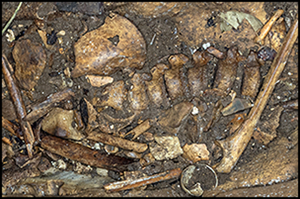Introduction
Knowledge of the ancient inhabitants of West Central Africa and their burial practices is very limited due to the lack of written sources and the scarcity of archaeological human remains in this part of the world. In this context, the discovery and analysis of the Iroungou Cave, Ngounié Province, Gabon (Figure 1), which contains thousands of scattered human remains associated with abundant artefacts, represents a wealth of exceptional and novel information.
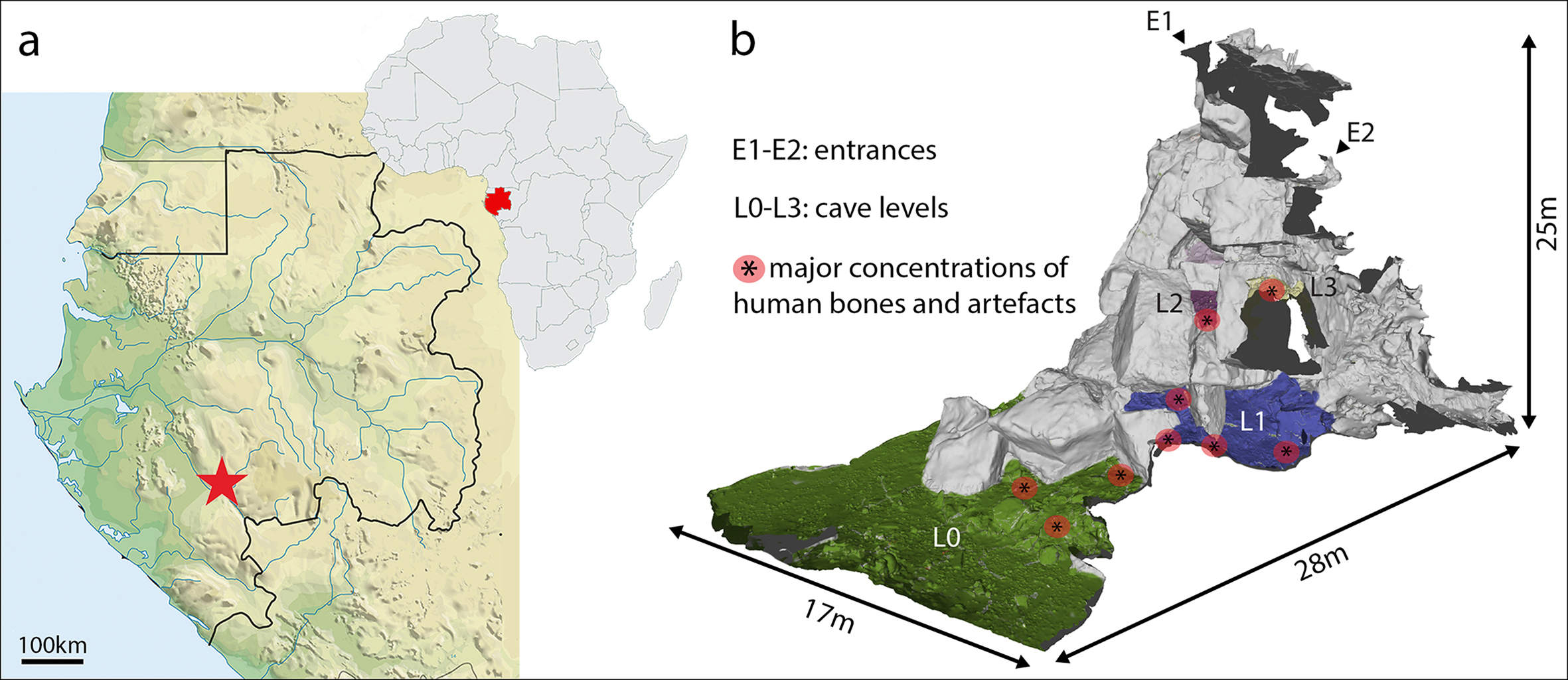
Figure 1. a) Location map showing the Iroungou site; b) 3D rendering of the cave showing the main cave levels and the location of the major concentrations of archaeological remains. Credit: P. Mora and S. Kacki.
The cave, discovered by Richard Oslisly in 1992 and first explored in 2018, is connected to the surface through two openings in its ceiling, and is today accessible only by abseiling. The cavity, 25m at its deepest, consists of four main levels, comprising a total area of approximately 2000m3 (Figure 1). Due to the difficulty in accessing and moving about within the cave—and to ensure the long-term preservation of the bones—only four expeditions have been carried out since 2018. All human remains were left in situ, while artefacts visible on the floor were collected after 3D photogrammetric and laser scanning recorded their locations.
A rich pre-colonial burial site
Skeletal elements and artefacts are scattered throughout the cave, with the densest accumulations directly below the identified openings in the ceiling (Figure 1). Skeletal preservation is highly variable, from complete to extremely fragmentary elements (Figure 2). Some of the bones are covered with sediment, encrusted in calcite or display rodent (porcupine) tooth marks, indicating post-depositional disturbances involving natural agents (gravity, water and animals). Conversely, there is no evidence for intentional manipulation of the remains by humans. Although very few anatomical associations are preserved (Figure 2c), all skeletal parts are represented, suggesting that cadavers, rather than dry bones, were either thrown from above or lowered into the cave.
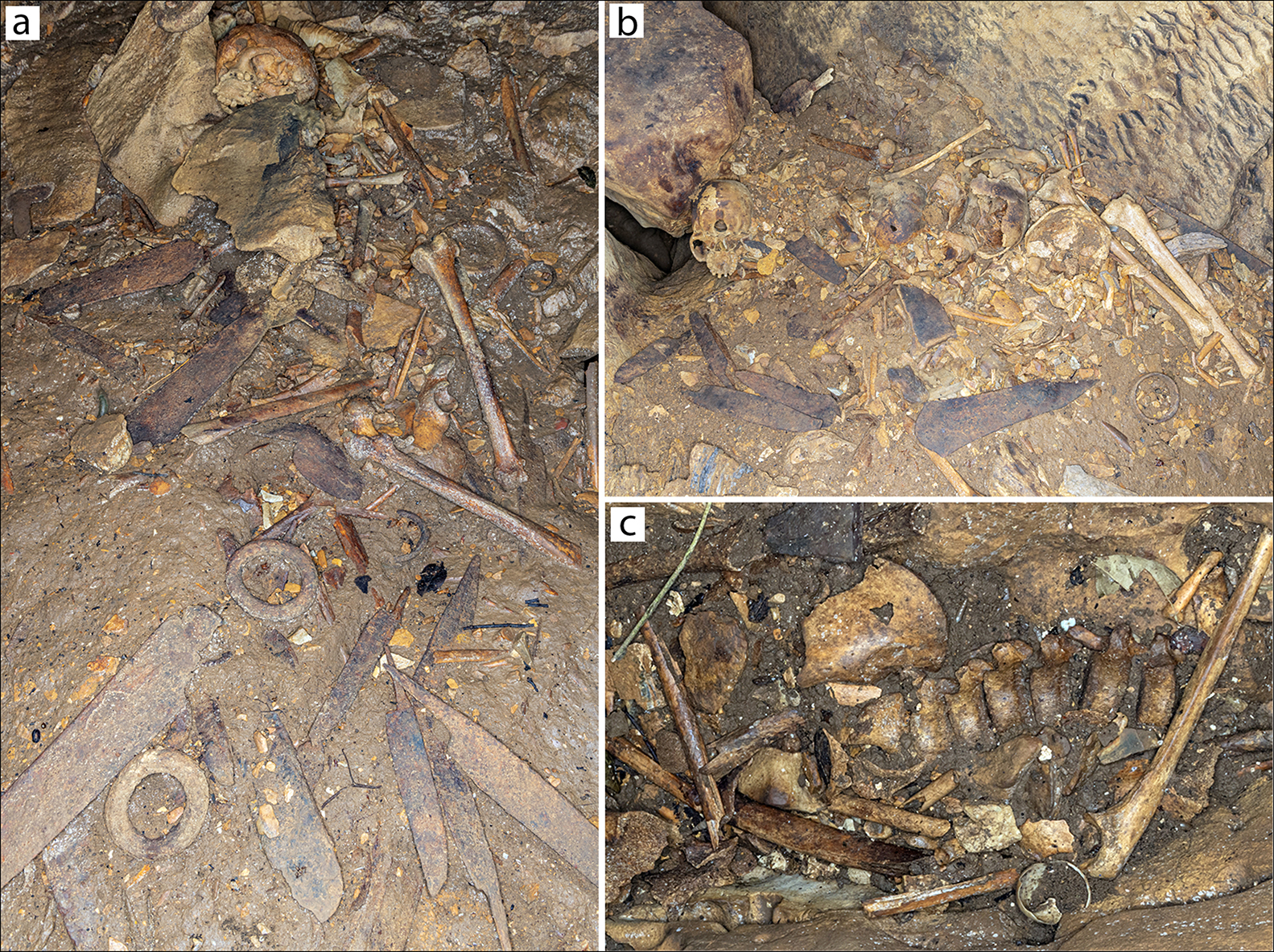
Figure 2. a–b) Examples of accumulations of human bones and artefacts; c) partially articulated lumbar vertebral segment and pelvis of a sub-adult. Credit: P. Mora.
Twenty bone samples of right femora were collected for dating purposes. Radiocarbon dates, from the samples that yielded enough collagen (n = 10), indicate that the cavity had been used to inter corpses on two or more occasions during the fourteenth and fifteenth centuries AD (Figure 3), just prior to contact with the Portuguese at the end of the fifteenth century.
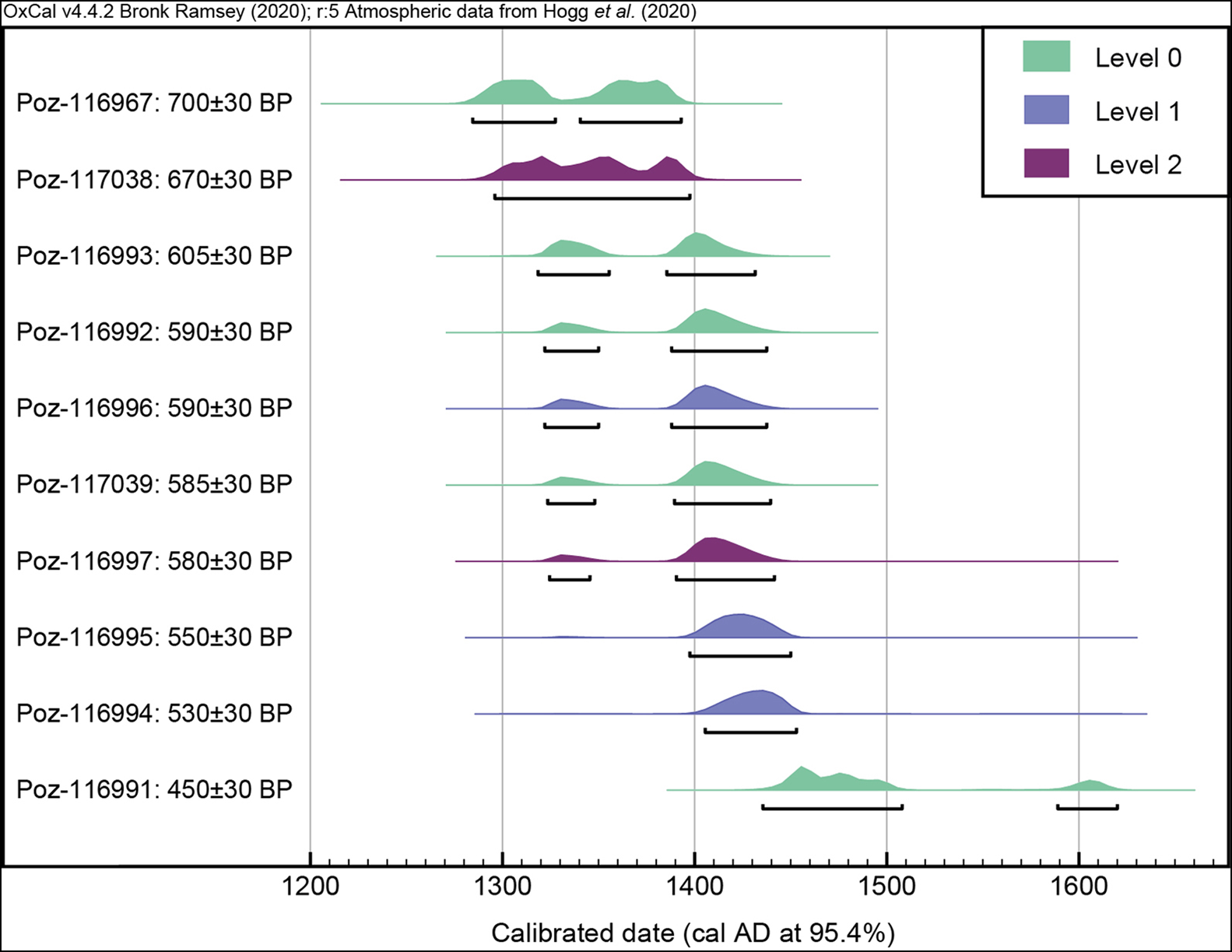
Figure 3. Radiocarbon dates of bone samples from Iroungou Cave. Dates were calibrated with OxCal v.4.4 (Bronk Ramsey Reference Bronk Ramsey2009), using the SHCal20 atmospheric curve (Hogg et al. Reference Hogg2020). Credit: S. Kacki
The associated artefacts include 486 iron and 26 copper objects, 127 Atlantic marine shells (15 of them being pierced), and 39 pierced carnivore teeth. The most represented metallic objects are bracelets and rings (38.7 per cent), knives (27.9 per cent), axes (13.5 per cent) and hoes (9.4 per cent). Unlike iron, copper sources are scarce in West Central Africa, and copper was considered a valuable metal for centuries in this area (Rademakers et al. Reference Rademakers, Nikis, De Putter and Degryse2018). The most likely source is the Mindouli area (Niari Basin, Republic of Congo), located approximately 400km from the site, which has been exploited since the thirteenth century (Rademakers et al. Reference Rademakers, Nikis, De Putter and Degryse2018).
Skeletal sample composition and body modifications
The minimum number of individuals (MNI) was assessed considering both the number of the most represented skeletal elements and age incompatibility. At least 24 adults (over 15 years old) were identified (based on the number of right segments of the mandibular corpus), as well as four non-adults. All age groups are represented from young children to middle-aged adults. From the in situ study of the accessible ossa coxae (Brůžek et al. Reference Brůžek, Santos, Dutailly, Murail and Cunha2017; Santos et al. Reference Santos, Guyomarc'h, Rmoutilova and Brůžek2019), the adult sample includes both females (MNI = 3) and males (MNI = 7).
Of the preserved maxillae (upper jaw) (MNI = 22), none displays central or lateral permanent incisors (Figure 4). This absence is not related to post-mortem losses, as alveolar resorption is evident in all cases. Instead, the symmetry of tooth loss and the systematic repetition in the sample clearly points towards ablation (the intentional removal of specific teeth), in the context of some cultural practice (Merbs Reference Merbs1968). No ablation is present in the Iroungou mandibles (lower jaws) with preserved incisal regions (MNI = 19). Ablation of anterior teeth alters pronunciation and induces highly visible changes in the facial characteristics (De Groote & Humphrey Reference De Groote and Humphrey2016), and thus acts as a strong ethnic marker. The systematic ablation at Iroungou suggests that all individuals shared at least some common values and beliefs. Intentional dental modification, including dental filling, chipping and ablation, has a long history in Africa. It has been repeatedly observed in skeletal remains of Africans (e.g. De Groote & Humphrey Reference De Groote and Humphrey2016), including those of slaves discovered outside the continent (e.g. Wasterlain et al. Reference Wasterlain, Neves and Ferreira2016). Interestingly, the ablation of all four upper permanent incisors (and none of the inferior ones) is a relatively uncommon form of dental modification in most parts of Africa. It has been mostly reported by nineteenth- and early twentieth-century ethnographers for West Central Africa populations (van Rippen Reference van Rippen1918; Lalouel Reference Lalouel1950), suggesting a long history and possible continuity of body-modification customs in the area.
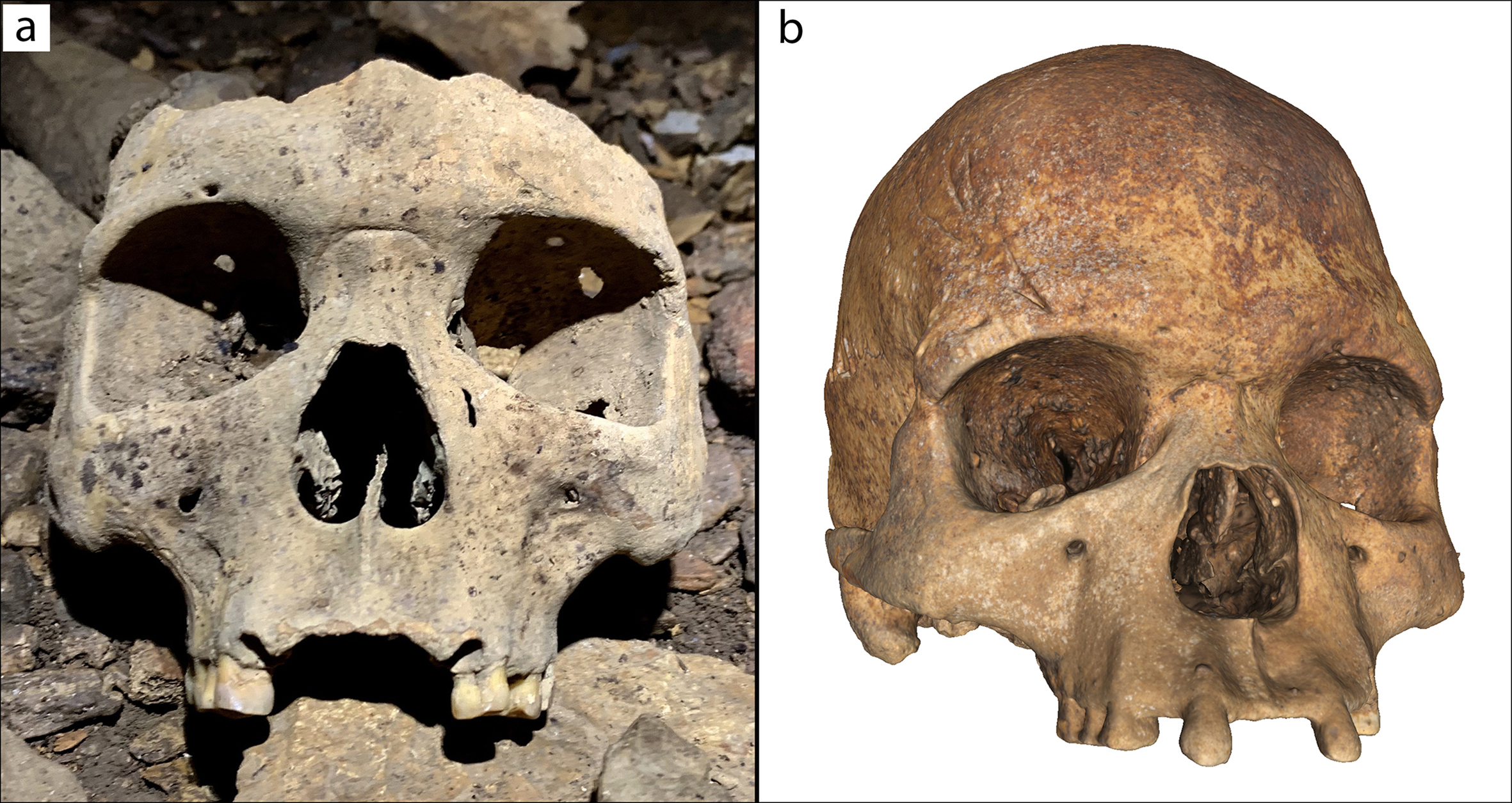
Figure 4. Photograph (a) and photogrammetric model (b) of crania showing incisor ablation. Credit: C. Gerin and P. Mora.
Customary burials, sacrifice or elite mortuary practices?
While a number of Late Iron Age burials have been described in West Central Africa (e.g. de Maret Reference de Maret1977; González-Ruibal et al. Reference González-Ruibal, Sánchez-Elipe and Otero-Vilariño2013), including some containing abundant iron artefacts, they mostly consist of deposits in burial pits located at open-air sites. The accumulation of bones of many individuals in a cave, associated with hundreds of metallic artefacts, has no known equivalent in the archaeological record of this region. The closest counterpart, both chronologically and geographically, is a thirteenth-century bone accumulation discovered in a former cistern in Benin City (Nigeria). This alleged mass burial contained the remains of more than 40 individuals (mostly young adult women), and has been interpreted as evidence of ritual sacrifice indicative of centralised authority (Connah Reference Connah1975). Although such an interpretation cannot be asserted for Iroungou, the richness of the material associated with the bones at least excludes the possibility that the cave was solely used for common funerary practices. The quantity of goods, demographic profile of the human assemblage and absence of obvious ante-mortem bone trauma also make improbable the connection of this deposit to warfare, and suggest it may rather have been a special burial place for important individuals, and possibly their accompanying dead (retainer sacrifices). Future archaeological excavations and bioanthropological studies will endeavour to test this hypothesis.
Acknowledgements
We would like to thank Agence Nationale des Parcs Nationaux and Olam International in Gabon, which co-initiated and funded this study, as well as the Institut français du Gabon for their support, the Centre National pour la Recherche Scientifique et Technologique for authorising research in the Gabonese national territory, and the two reviewers for their useful comments.
Funding statement
Fieldwork was funded by the Olam Sustainability Framework.


